Aquarium equipment can sometimes seem a bit daunting, there’s so many different things available and it can be difficult to know what are the most suitable items for the set up you are aiming for. Some things are essential to all set ups, some are optional depending on the sort of set up you wish to achieve. This article focusses on the things you are likely to need for a freshwater set up. We are working on putting together a similar guide for aquarium equipment for marine aquariums and set ups.
This article covers the aquarium equipment that most set ups require in order to provide a safe and healthy environment for the fish that live there. It may seem a little daunting but there’s no need to worry, it’s quite straightforward really and there are plenty of experienced people happy to help you out on the forums in our recommended forums section. We speak from experience when we say it’s so much better to be fully up to speed with everything you might need before you start so that you don’t suddenly find yourself lacking that crucial thing right at the wrong moment!
Many items of aquarium equipment can be bought secondhand so it’s always worth checking out online sale sites, car boots and even the local tip for bargains.
Before you buy anything you will need …
An understanding of the nitrogen cycle, the fishless cycle, and the needs of the fish you wish to keep.
The most important thing you need for all set ups is an understanding of the nitrogen cycle, and basic water chemistry. Next you need a good understanding of the needs of the fish you wish to keep. The fish you want to keep will influence the set up you need to provide. On the other hand, the set up you are able to provide may determine the fish you are able to keep. For example, if you are unable to provide a large aquarium then you will not be able to keep very large species. Some fish have specific requirements regarding décor for example so you will need to make sure you’re prepared for what they need, while others are less fussy. Make sure you do plenty of research into your chosen species before you bring them home to ensure that you know how to care for them. Our article Researching fishkeeping – how, what and why will guide you through the sort of things you need to understand and gives further information on where to look for species information, caresheets and fish profiles.
Aquariums
There are numerous options available on the market from ‘plug n play’ aquariums to bespoke ones. Whether you buy new or find a second hand bargain you must be sure that the aquarium will be suitable for the maximum adult size of the fish you want to keep. Some people start small and upgrade as the fish grow but this is very difficult to do in reality. Many people find it hard to judge when a larger aquarium is needed and inadvertently risk the health of their pets by not providing them with the correctly sized aquarium when they need it. It’s far easier, cheaper and a lot less work to buy the right sized aquarium in the first place. Take a moment to think about the work needed to move an entire set up from one aquarium to another with all the opportunities for chaos this involves and hopefully you’ll agree that it’s better to get it right from the start! You should also consider that your circumstances might change. While you may have every intention of upgrading to a bigger aquarium when you first get your fish, unforeseen circumstances may prevent this. This is why we recommend that you buy the right sized aquarium from the outset.
Have a read of our article about understanding fish stocking guides to help you work out what size aquarium is needed by various species. It’s also worth reading our article on ‘Do fish grow to the size of their tank’ as this unfortunate myth is still widespread and causing many problems for many fish.
Aquariums come in many shapes and sizes. A traditional rectangular glass aquarium is usually the best option for most people. These provide a good surface area for gas exchange which is beneficial to the health of the fish as it means plenty of oxygen is able to get into the water. Fish generally prefer to swim side to side. A rectangular aquarium provides a good length for them to swim along. Corner aquariums can give a reasonable volume of water in a convenient space, and the swimming length is often quite good too. Circular or bowl shaped aquariums make it harder for fish to enjoy a good length of water for swimming. These aquariums can work for certain species but the shape of aquarium you choose must be suitable for the species you wish to keep so make sure you’ve researched properly beforehand. Remember that the fishes’ requirements always take priority over the aesthetics of any particular style of aquarium.
You can use our calculator to work out the volume of your intended aquarium, or to get an idea of what sort of volume you could fit in the space you’ve got earmarked. Once you know the volume of your aquarium you should subtract approximately 10% for décor. Décor displaces water so will slightly reduce the amount of water your aquarium can hold.
Aquarium stands
Aquariums weigh a substantial amount when full so you need to be sure that anything you use as a stand is capable of bearing the weight. Many aquariums have stands available to go with them and these are guaranteed to support them properly. If you buy a new tank you should check the guarantee carefully in case it is invalidated if you don’t use a certain stand. If you choose to use something else, or make your own, you should work out how much the whole aquarium will weigh when full of water and substrate before choosing or making a stand. You can use our calculator to work out the weight. Even a smallish aquarium of seventy litres will weigh close to ninety-five kilogrammes or fourteen stone when full of water and with gravel substrate.
Aquarium hood/lid
Most aquariums need hoods or lids. Some fish can be ‘jumpers’ by nature so you don’t want to find your beloved pet has made a leap and ended up down the back of the aquarium! Hoods also prevent cats from having a fish around in the aquarium so are essential if you have pet cats too. Hoods help prevent excess water evaporation and are often used to hold lights, and sometimes filtration. It is possible to do without a hood if you want an open topped aquarium but you must be certain your fish will not jump out and nothing else will jump in!
Aquarim Filters
Please see our article on the nitrogen cycle and fishless cycling for more information on the role the filter plays in the aquarium set up.
There are a few different types of filter available. Filters work by drawing water in one side and sending it through a series of filtration methods before pouring it back into the aquarium. Whichever type you choose you will need to be sure that it is rated for the size of aquarium you have. Filters come in different sizes and different flow rates. They are usually ‘rated’ for certain sizes of aquarium and this will be specified in the manufacturer’s details. The type of filter you choose will depend on what sort of set up you are aiming for and what fish you want to keep. Below are the most commonly used types of filter, there are others but we’ve chosen to focus on these for the purpose of this article.
Internal filters sit inside the aquarium. These are sometimes included in the purchase of an aquarium and if so are often attached in place already so you don’t need to worry about installing it yourself. Some are able to be removed though if you prefer to change it for an alternative filter. There are plenty of different shapes and sizes available, most are attached by means of suction pads on the back which stick to the glass. They operate on mains power. Different filters require different media, some use sponges, some use ceramics and some a mix of both.
These are suitable for smaller set ups, or for lightly stocked aquariums. Their smaller size makes them unsuitable for larger communities or big, messy fish as they can’t hold enough media to grow a big enough colony of bacteria to cope with the waste.
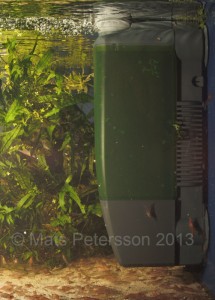
External filters sit outside the aquarium, usually underneath in a cabinet or stand and also run on mains power. Plastic hose runs from the inside of the aquarium to the filter and back again. They need to be below the level of the aquarium to operate effectively as they use gravity and the siphon effect to help the pump/powerhead. The filter houses a pump/powerhead which draws water out of the aquarium, through the hose and into the filter. The water is then pumped back into the aquarium through another hose.
External filters can be quite simple, or fairly all-singing all-dancing. Eheim’s range includes external thermofilters which have a heating element built into the filter itself meaning no separate heater is required to go in the aquarium. There are also filters with electronic controls which allow you to control flow rates etc. and even link your filter to your PC to monitor it!
External filters are popular for larger aquariums as the larger size of filter needed makes it difficult to accommodate a suitably sized internal filter. They are also popular for messy fish which produce a lot of waste as the larger volume of media they can hold provides a larger surface area for filter bacteria to live on. They tend to use a mix of ceramic and sponge media.
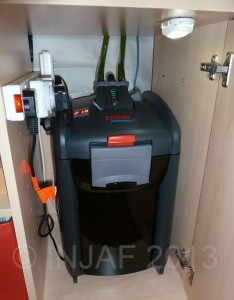
Air-driven sponge filters are suitable for small and lightly stocked aquariums. They are popular for fry aquariums and shrimp aquariums as the tiny creatures can’t get sucked inside as they might with an internal or external canister filter. The filters consist of a plastic tube with a sponge attached to one end which sits inside the aquarium. The plastic tube is attached to an airline powered by an air pump. The movement of the air through the tube makes the water circulate through the tube as well. The water is drawn into the tube through the sponge, it is the sponge that catches debris and houses the filter bacteria.
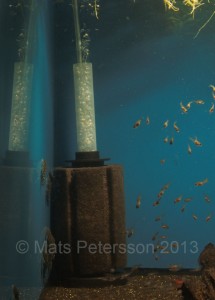
Undergravel filters are often considered slightly old-fashioned, but as with most things they have their place if used correctly. They work by means of a grid that sits on the bottom of the aquarium, with a layer of gravel over the top. Uplift tubes, like those on air-driven sponge filters, are attached to the grid. The filters are powered by air pumps, or powerheads, and draw water down through the gravel and into the uplift tubes to be returned to the aquarium. The gravel acts as the filter media and this is where the bacterial colony lives. These can be reasonably efficient filters but you do need to keep an eye on debris and waste accumulation in the gravel. They are not suitable for planted aquariums as the plant roots prevent water from moving freely across the plate. They are also not suitable for fish that like to dig.
Filter accessories
External filters need tubing to connect them to the inlet and outlets in the aquarium. Tubing is usually provided with new purchases but you may need longer lengths depending on your set up, or need to buy new if you’ve bought a second hand filter. Tubing comes in a variety of diameters depending on the size of your filter so make sure you know what size you need when you go shopping. Most aquatic stores will cut you the length you need from a large reel, so check the length you need beforehand. It’s better to buy slightly more than you think you need than find out you’ve slightly underestimated.
Spray bars are popular additions to the outlet of a filter. The outlet is the bit that returns water to the aquarium. A spray bar is a rigid tube with holes along it, the water comes out through the holes and distributes across the aquarium. These are not essential however. They are often supplied as part of a filter kit.
Filter media refers to the sponges, ceramics and other filtration items that sit inside the filter body. Sponges and ceramics remove debris mechanically by trapping bits and pieces and preventing them returning to the aquarium. They also operate biologically by providing a home to the filter bacteria which process the fish waste from toxic to non toxic. Some types of media are for specific purposes e.g. phosphate removal and these types of media also need to be housed inside the filter body. Newly purchased filters usually come with media provided, but you may wish to swap it for a different type, or add additional media depending on your requirements. If you’ve bought a second hand filter you should consider replacing all the old media for new.
Venturi valves fit to internal filters (depending on the model) and allow the filter to suck in air as well as water so that when the water is returned to the aquarium it returns a flow of bubbles. This can be helpful in keeping the water well oxygenated. Certain models of filter come with them when you buy them from new but you don’t have to use them if your fish don’t need them.
UV sterilisers are not crucial but they can be useful for delicate species to help keep pathogens at bay. They have a mixed reception in the online community, some keepers find them to be effective but others don’t find they make much of a difference. The type pictured below fit to an external filter inline with the filter hosing on the output side, but could be powered by a small pump. The water flows past an Ultra Violet light as it goes through, the UV light kills various pathogens and algae spores.
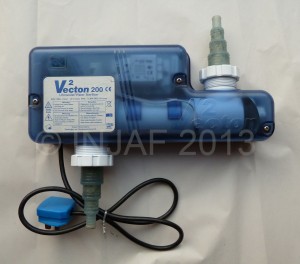
Aquarium Lighting
Some aquariums come with lighting, some don’t. Lighting is not essential for all set ups but it is certainly beneficial for most. Lighting on the aquarium isn’t needed for the fish themselves, as long as there is some light somehow for a number of hours to ensure a difference between day and night, such as from a window. If you want live plants for example, you will need suitable lights to help them grow. Nocturnal fish can benefit from moonlighting which is a blue light mimicking the light of the moon on a dark night. Moonlighting should be set to come on at twilight to encourage your nocturnal fish to venture out so you can see them. There are several different lighting systems available.
The most commonly available type of lighting is fluorescent tubes. These come in different sizes, T5 and T8. This refers to the diameter of the tube; T5 tubes are five eighths of an inch in diameter, T8 tubes are eight eighths (or one inch!) in diameter. The metric equivalent of these is 16mm and 25mm respectively. If you need to buy replacement tubes for your set up make sure you know what diameter and length you need.
Tubes come in many different lengths, in most cases the lengths do not correspond to the length of the aquarium. For example, for a four foot long aquarium you will not need a four foot long light tube, you are more likely to need a three foot one. As with the diameter, make sure you know what length you need when you go shopping for replacements.
For T8, the length for a given wattage is always the same, but for T5 there are two types, “High Output” and “Normal Output” tubes. These are usually not interchangeable, but they do come in the same sizes for both types. Aquarium lighting is nearly always high output.
Fluorescent tubes come in different light spectrums, some are specifically aimed at encouraging good plant growth while others are designed to enhance the colours of the fish. Whichever you choose will depend on what sort of set up you are aiming for.
It’s worth mentioning that tubes are available from other sources than fish shops, and a “Daylight” 6000-6500K T8 or T5 tube works just fine as a generic aquarium light and is often cheaper to buy.
Air pumps, bubbles and all that jazz
Air pumps are just that, pumps which pump air into the aquarium. This helps provide aeration by increasing the surface area of the water for gas exchange. Each tiny bubble has its own little surface area which helps oxygen get into the water. Air pumps help increase turbulence at the water surface, further enabling oxygen to be taken into the water. The position of the air stone in the aquarium can help avoid dead spots and improve circulation as the movement of the air through the water effectively ‘drags’ water up from the bottom of the aquarium.
Air pumps sit outside the aquarium and feed air into the water through an airline. An airline is a thin plastic tube which is attached to the air pump outside the aquarium and takes the air from the pump into the aquarium. Airline is a standard diameter, you simply buy as much as you need for the arrangement you want. If you choose the blue silicone airline be warned that over time it contracts where it is in the water, so make sure you leave enough ‘slack’ to account for this inside the aquarium. Airline tends to go stiff with age so you may need to replace it if you decide to alter your layout at any point.
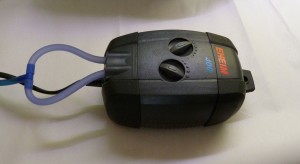
Airline is usually attached to the aquarium sides with suction cups. You can buy these in packs and they are usually quite cheap to buy. As with the blue airline, these change slightly over time when in water and the plastic can become stiffer and less able to stick to the glass. You can simply replace with new as needed, or sometimes a few minutes in a mug of freshly boiled water will rejuvenate them for a time. If you are confident you won’t want to move your airline you can use aquarium silicone to stick the suckers to the glass before you fill the aquarium with water.
It is important that you have a non-return valve in the airline between the pump and the water. These are sometimes included with air pump kits but often you have to buy them yourself. In the event of a power cut they prevent water siphoning from the aquarium through the airline and into the pump.
Air pumps can power a variety of ornaments or air stones. Whatever you choose you must make sure that it is suitable for the fish you will be keeping. Some fish like a lot of bubbles, some like a few and some don’t like them at all. There are all manner of decorative items available from gnashing sharks to treasure chests but there are also plenty of more subtle options such as plain air stones or bubble curtains. Have a good browse around your local shop, or look online to find one that you and your fish will like.
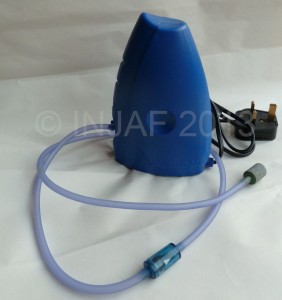
Aquarium heaters
Heaters are important for tropical set ups where the water temperature often needs to be higher than the ambient temperature of the room the aquarium is in. Many keepers of temperate/coldwater fish also keep heaters in their aquariums to ensure steady temperatures during winter when temperatures in the home can drop during the night when central heating is off. There are various different types of heater and different sizes available for different sized aquariums. The general rule of thumb is one watt per litre of water. For larger set ups it can be better to have two smaller heaters at either end of the aquarium to ensure even distribution of warmth.
‘Traditional’ style heaters are glass tubes with a heating element and thermostat. These go inside the aquarium and should be attached to the rear glass. They should be in an area of good flow to prevent ‘hot spots’ forming and creating uneven water temperatures. Plastic heater guards are recommended to prevent any curious fish injuring themselves if they get stuck.
Rena Smartheaters work by replacing the inlet for the filter with a heater, the water gets drawn through the heater on the way to the filter.
The Smartheater is on the left, the traditional style heater on the right in the photo shown below.
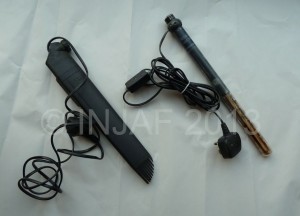
Inline heaters fit in the filter tubing between the filter and the aquarium and warm the water as it passes through them.
Some filters have heating elements incorporated, for example the Eheim Thermofilter range. These have a heating element in the filter canister and provide a constant temperature.
A thermometer is useful to help keep a check on water temperature. A good quality digital thermometer is recommended. These will help you make sure that the thermostat on your heater is accurate (some can be a little off, it’s wise to check) and to check that your heater is optimally positioned for an even water temperature. It will also be useful when you are trying to temperature match fresh water for a water change with the temperature of the water in the aquarium.
Décor and accessories
Substrate is simply the term for whatever you use to cover the bottom of your aquarium. It is important that you know what sort of fish you will be keeping before you choose your substrate. Certain species have specific requirements which you will need to cater for in order to keep them healthy. It is no mean feat to change your substrate if you decide you made the wrong decision so take some time to think it through and choose something that you will like for many years to come and that your fish will also like. You can use our calculator to work out how much substrate you will need for your aquarium.
Sand is popular, especially with fish that like to dig or burrow. Many species of loach and catfish do well with sand as larger particle substrate can damage their barbels. You can buy specific aquarium sand but many people prefer to use children’s play sand as it serves the same purpose and is often cheaper. You should ensure that the sand you choose is inert, that is to say it will not affect the water chemistry by changing the hardness or pH. A quick test is to drip some vinegar on a sample, if it fizzes it is not inert.
Gravel is also popular. There are a wide range of gravel colours and sizes. When choosing your colour be sure to consider the preferences of the fish over your own personal preferences. Fish won’t naturally encounter neon pink gravel and bright colours can stress them leading to illness and possibly death, it might sound melodramatic but stress can have a serious affect on fish and can be caused by things you might not expect. We recommend natural colours, these are preferable for the fish as they mimic the colours the fish would naturally encounter.
Soil and planting mediums can be used either as standalone substrates depending on the product, or capped with a layer of sand or gravel. These are suitable for aquariums where a planted set up is required. Many plants do just fine without them though so you can still achieve a nice planted set up without them. If you are aiming for a heavily planted set up you may wish to consider a specialist planting substrate.
Décor is often dictated by the requirements of the fish but in many cases you can add ornaments and plants as you choose. Whatever you choose be sure it is suitable for the fish you are keeping and won’t stress or upset them as this can damage their health. Wood is a popular choice for many set ups. Bogwood, mangrove root, mopani wood etc. as sold in aquatics stores are all suitable for aquarium use. Don’t be tempted to add any wood you’ve collected yourself as it might be unsuitable and leach toxins into the water. If you have some wood you would like to use but are unsure about it you can ask on one of our recommended forums for advice.
Most aquatics stores sell rocks which are suitable for use in aquariums. If you collect rocks from a beach or other area you must be absolutely sure that you are legally allowed to remove them from the collection area (check your local bylaws or ask your local council for advice), that they are completely clean and free of contaminants, and that they are inert and will not affect your water chemistry.
Many species of fish like caves or other similar hiding places. You can use our calculator to work out what size cave or hidey hole will be right for your catfish.
Live plants are a great addition to the majority of aquariums. Your choices may be limited if you have large, boisterous fish or fish that enjoy eating plants but don’t let this put you off live plants. Plastic or silk plants can also be used to add shape and movement to an aquarium, although we think that once you’ve tried live plants you won’t want plastic ones. A good compromise for big, boisterous fish is to have a mix of real and fake plants. Don’t be afraid of using live plants, there are plenty that are suitable for beginners or for fairly basic set ups.
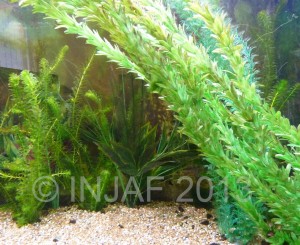
Lead plant weight is useful not only for weighing down bunches of stem plants but also for wrapping round airline before burying it under the substrate. This helps keep it in place and stops fish from digging it up.
Water and water test kits
Water Conditioner is used to treat tap water to make it safe for fish. You might think if it’s safe to drink it ought to be safe for fish but this is not the case. Tap water contains chlorine, and often chloramines which are used by water companies to keep bacteria at bay. Unfortunately these chemicals damage filter bacteria and can harm the fish too. Water conditioners also remove heavy metals from the water which means these cannot be absorbed by the fish and risk causing them health problems. You should always use water conditioner on tap water before adding the water to the aquarium. Some water conditioners can be used to detoxify ammonia and nitrite in an emergency. Others contain additives such as aloe vera which is intended to help protect the fishes’ slime coat. When you choose your water conditioner it is best to choose one which deals with chloramines as this is being used more frequently by water boards.
Water test kits are your friend. A test kit is an essential piece of kit for every fishkeeper. Regular testing helps spot any potential problems before they arise so you can take remedial action if necessary. For freshwater systems you should be able to test for ammonia, nitrite, nitrate, pH, GH and KH as a minimum. There are various kits available on the market, the API Master Test Kit is a good choice as it covers most things you will need to test for. GH/KH kits are available separately to this.
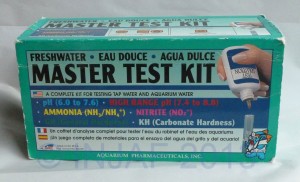
Aquarium Cleaning
Gravel vacuums are used to remove grot and debris from the substrate. Some will remove water at the same time so are great for water changes, others are battery powered and circulate the water through a mesh to catch dirt and return water to the aquarium.

Magnetic algae scrapers are incredibly useful tools. These consist of two parts, both with magnets, one bit inside the aquarium and the other on the outside. As you move the external bit across the glass the internal bit scrapes algae off the inside of the glass. Be cautious about using these on acrylic aquariums as acrylic scratches more easily than glass. They are not essential but they do save a lot of time spent up to your armpits in an aquarium trying to scrub off the algae with a sponge. The Hobby Blade scrapers are very good but do be careful when handling them as they are rather sharp (as one of us knows to their cost!).
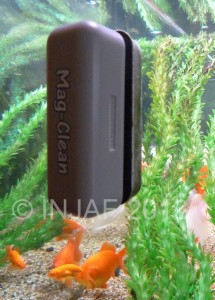
Old credit cards are popular alternatives to algae scrapers, you can use these as you would use an ice scraper on a car windscreen. They do require you to get your arms in the aquarium though so you may prefer a magnetic scraper if your fish like a nibble!
Fish nets are useful for the obvious job of catching your fish should you need to move them to a different aquarium or to examine them more closely in case of illness. But they are also very useful for catching bits and pieces in the water, stirring up and catching surface grot on sand, and retrieving things like plant weights inadvertently dropped in the aquarium during maintenance.
Water changes and cleaning can be made much easier with a few key items. A good quality bucket is a must. Most hold about 10 litres but it’s very useful to measure out the 10 litre mark with some water and a measuring jug if your bucket is not marked already and then mark on the outside with a permanent marker. A plastic measuring jug is useful for many and various things during water changes, once you have one you’ll wonder how you did without it. A large one and a small one are a good idea.
Non stick washing up sponges (make sure they don’t come pre-soaped!) are good for cleaning glass and ornaments. Take some aquarium water out and rinse the sponge well in it before you use it for the first time. ‘Eco cloths’ or microfibre cloths are excellent for cleaning the front of the glass without needing to use chemical cleaners.
If you have a large aquarium you may find a large, food safe dustbin a helpful item for storing fresh water in readiness for your water change. A normal dustbin is good for holding dirty water being siphoned out of the aquarium if you have a large aquarium. Otherwise buckets or plastic garden trugs are useful. Plastic sheeting, or large plastic bags are very helpful in protecting the surrounding area from drips and splashes during water changes. Depending on your choice of filter you may find a plastic funnel useful for pouring water into the filter for priming it.
For large aquariums, you may find a dirty water pump, or rain butt pump and some garden hose useful for pumping old water out of whatever container you’ve siphoned it into. These pumps are also useful for pumping clean water out of a storage bin and into the aquarium.
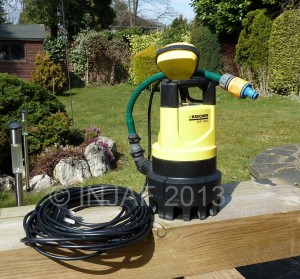
A selection of brushes is good to have at hand. A new washing up brush and bottle brush are great for cleaning filter inlets and getting into corners. A filter tube cleaning brush on a long wire is invaluable for cleaning the tubes on external filters as these can gather quite a lot of dirt and slow the flow on your filter over time.
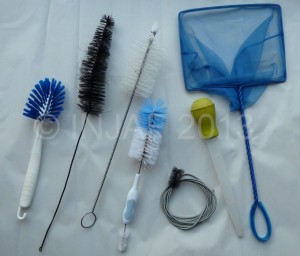
Battery powered stick on cupboard lights are great for helping you see what’s plugged in where when you’re on hands and knees trying to find the right switch in your cupboard! Stick on labels are also very useful for labelling plugs so you know that you’re unplugging what you intended to.

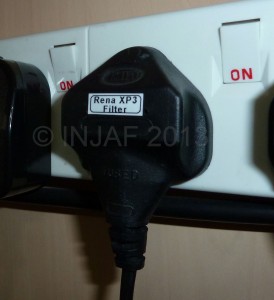
We strongly recommend you have a good supply of old towels and tea towels that you keep near the aquarium. The number of times you need one when the nearest one is out of reach is remarkable!
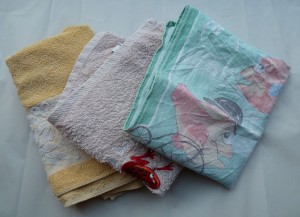
Food
It may sound obvious but make sure you have a supply of appropriate food ready for your new charges. You should research their feeding requirements as part of your research into their overall needs. Some fish have very specific feeding requirements and there is a huge variety of different foods available now from flakes and pellets to frozen food, so make sure you are fully up to speed on the different types of food your fish will enjoy.
A turkey baster can be very handy for feeding shy fish and getting frozen food distributed evenly so one resident doesn’t suck it all up before the others get a chance.
And finally, a comfy chair and a nice cuppa so you can sit and relax while watching your happy, healthy fish swimming about their lovely home.
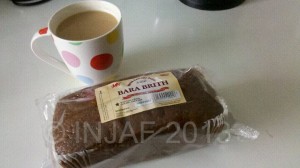
This article is by no means a full and complete list of all aquarium equipment you might need to cover every eventuality, and every possible set up and requirements. But it covers the basics and makes sure you won’t miss out on any of the important things. For more information about setting up an aquarium please have a look at one of our recommended forums for more information and advice.
Glossary of Terms
If you’re not sure what some of the terminology refers to you’ll more than likely find your answer in one of the glossaries linked to below. If not, visit one of our recommended forums and someone will be sure to help you out:
Glossary of terms – from planetcatfish.com
Glossary of terms – from seriouslyfish.com, use the glossary drop down on the right of the profile search
Further reading:
Don’t forget to check out our other Beginners’ Guides, have a look at our Care and Information section, have a read of our Articles & Guides and visit the Big Fish Campaign page (you can find them on Facebook and Twitter too).
Author: Suzanne Constance
Photographs courtesy of: Suzanne Constance and Mats Petersson




